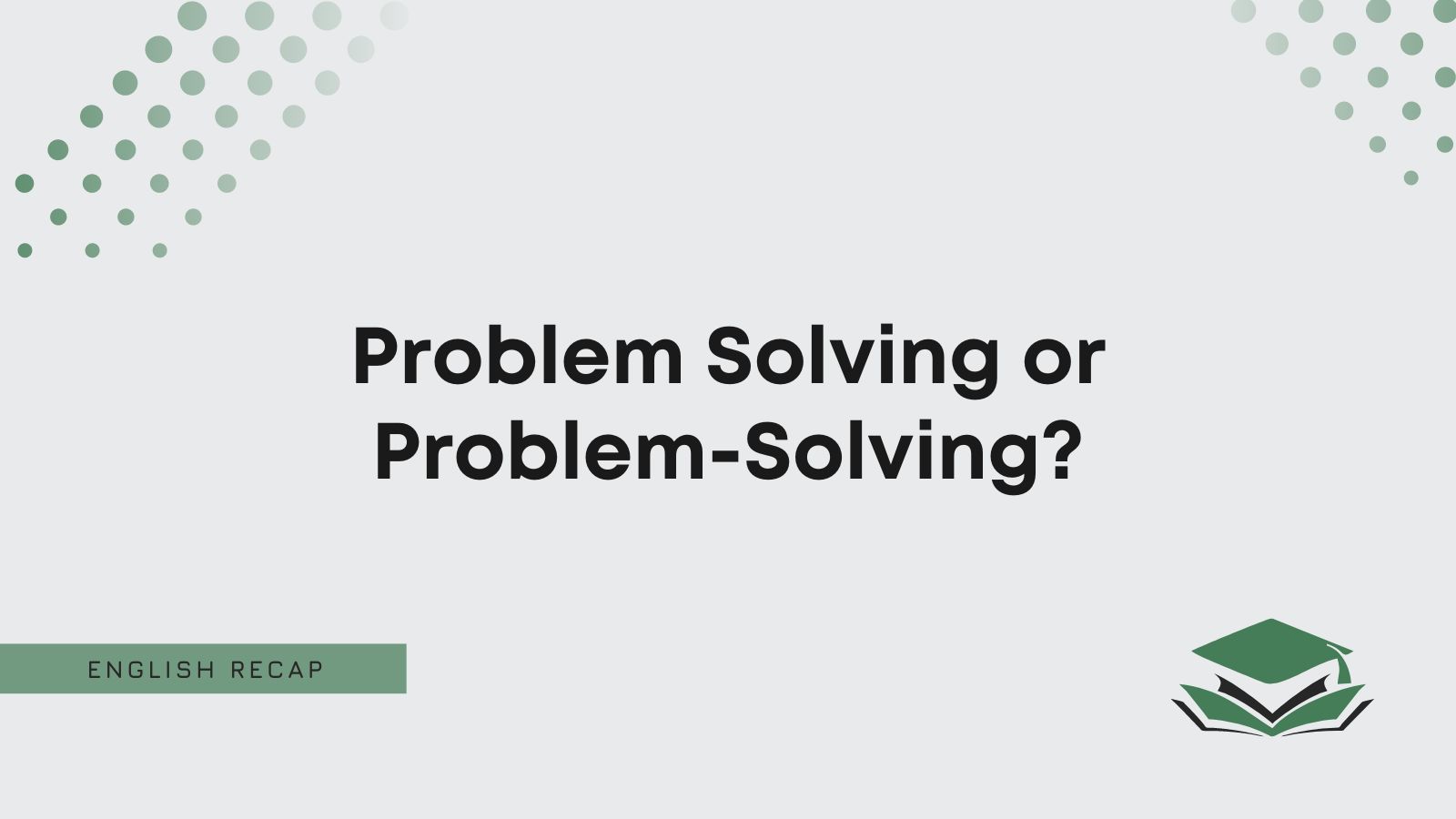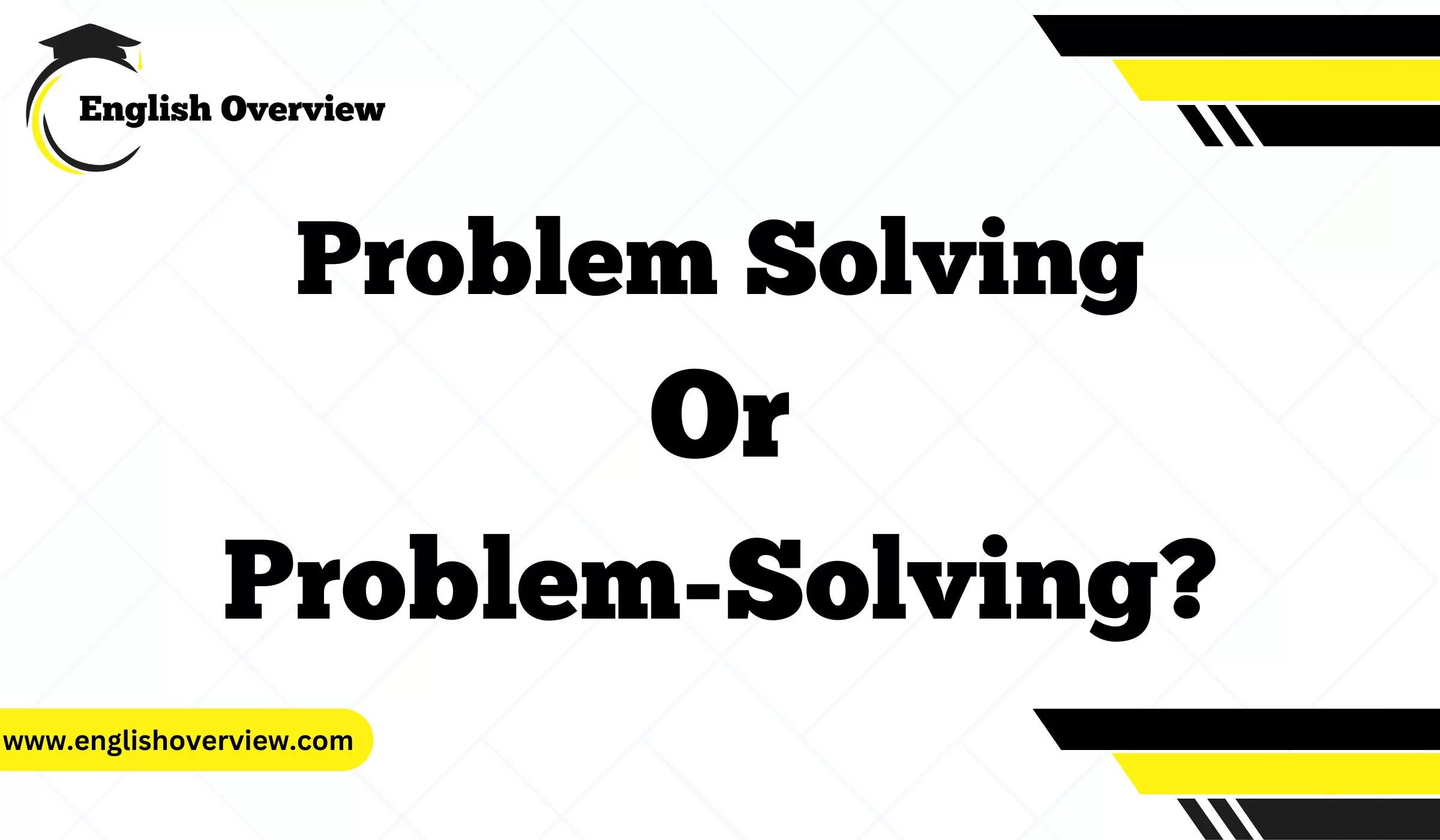

Problem Solving or Problem-Solving?

The term problem-solving with a hyphen is an adjective that describes nouns in a sentence. E.g., “The problem-solving abilities of this program are excellent.” Furthermore, the term problem solving without a hyphen is a noun. E.g., “He is excellent at problem solving.”
The term problem solving can appear as two different word types, a noun or a compound adjective.
When problem-solving has a hyphen, it is an adjective describing a noun .
For example, in this sentence, problem-solving describes capabilities , which is a noun. Therefore, you need to include a hyphen.
- Her problem-solving capabilities are outstanding.
However, when you use problem solving as a noun , the term is usually not hyphenated because it doesn’t modify anything.
- She is an expert at all types of problem solving .
Furthermore, the rule of using a hyphen for the adjective but not for the noun is correct grammar according to AP Style and the Chicago Manual of Style .
Sometimes in English, the rules concerning punctuation, such as hyphens, are vague. For example, in the Cambridge and Oxford dictionaries, the noun problem-solving appears with a hyphen.
Essentially, you should always use a hyphen for the term problem-solving as an adjective. However, for problem solving as a noun, unless you follow a specific style guide like AP that does not use a hyphen, you can choose whether to hyphenate the noun. Just make sure that you are consistent with your choice.
In addition, Google Ngram shows that problem solving without a hyphen is slightly more popular in the US than with a hyphen. However, in the UK , the hyphenated version is slightly more frequent.
Now that you have learned the basics concerning the term problem solving, please keep reading the rest of the article to learn more about using the two variations of problem solving .
Problem Solving
The term problem solving as two words without a hyphen is the noun form.
In terms of use, it relates to resolving problems, which can relate to problems in a specific discipline or more general problems.
In the following examples, the term problem solving refers to the act of solving problems. Therefore, we do not need a hyphen.
- Her inability to perform problem solving on any task means that she loses her temper quickly.
- You should include problem solving as a skill on your resume.
- In team projects, effective problem solving can lead to innovative solutions and successful outcomes.
- Problem solving is not just about finding immediate answers but understanding the root cause of the issue.
- Her approach to problem solving often involves breaking down complex tasks into manageable steps.
Furthermore, you should use the above rule when following both AP Style or the Chicago Manual of Style.
Problem-Solving
The term problem-solving as one word with a hyphen is a compound word that appears before a noun. Hence, it modifies the noun .
For example, in the following sentence, the word problem-solving modifies the noun skills.
- His problem-solving skills are the best in the company.
- Her problem-solving approach is both methodical and creative, making her a valuable asset to the team.
- The workshop focuses on problem-solving techniques to address everyday challenges.
- Many employers prioritize candidates with strong problem-solving abilities in dynamic work environments.
- The game challenges children to use their problem-solving instincts to navigate various puzzles.
Furthermore, you will come across some sentences in which the noun problem solving has a hyphen.
As shown in these examples:
- You need to work on your problem-solving if you want to become an engineer.
- Improving your problem-solving is essential for success in mathematics.
- Mastering problem-solving will greatly benefit you in software development.
This is often a stylistic choice . However, in writing that follows AP Style , you should not use a hyphen with the noun form of problem solving.
Problemsolving
The word problemsolving as a single word with no hyphen or space is incorrect , and you shouldn’t use it in this format.
There are two ways you can use the term problem solving .
The first is as a noun, in which case there is no hyphen, but there is a space.
- Correct: He is excellent at problem solving because he never gives up. (noun)
- Incorrect: He is excellent at problemsolving because he never gives up. (noun)
- Correct : She has a knack for problem solving , especially in high-pressure situations. (noun)
- Incorrect : She has a knack for problemsolving , especially in high-pressure situations. (noun)
Also, you can write problem-solving as an adjective, in which case you need a hyphen.
- Correct: He is excellent at problem solving because he never gives up. (adjective)
- Incorrect: He is excellent at problemsolving because he never gives up. (adjective)
- Correct : They often turn to her for advice on problem solving in challenging situations. (adjective)
- Incorrect : They often turn to her for advice on problemsolving in challenging situations. (adjective)
That’s all you need to know about the grammar rules concerning the words problem solving , problem-solving , and problemsolving . Rest assured that your sentences will be correct if you follow these!
- Half Day or Half-Day?
- Well Deserved or Well-Deserved?
- Well Written or Well-Written?
- World Class or World-Class?
We are a team of dedicated English teachers.
Our mission is to help you create a professional impression toward colleagues, clients, and executives.
© EnglishRecap

Problem Solving or Problem-Solving?
The term “Problem-Solving” or “Problem Solving” often takes center stage in discussions about overcoming challenges. However, the nuances in its usage can be perplexing. This exploration aims to dissect the word, observing its forms as a noun, adjective, and verb. Through five examples for each category, we’ll emphasize correct spelling and punctuation, while delving into the importance of adhering to grammar rules.
The focal point will be the distinction between “Problem Solving” as a verb phrase, “Problem-Solving” as a hyphenated adjective or noun, and the incorrect form “Problem Solving.” Furthermore, we’ll highlight the consistency in usage between UK and US English.
The Noun Form: Problem-Solving
Correct examples.
- Effective problem-solving requires a systematic approach.
- The team showcased remarkable problem-solving skills during the crisis.
- Our workshop focused on collaborative problem-solving techniques.
- She excelled in the art of creative problem-solving .
- The conference highlighted the importance of collective problem-solving efforts.
Incorrect Examples
- Effective problem solving requires a systematic approach.
- The team showcased remarkable problem solving skills during the crisis.
- Our workshop focused on collaborative problem solving techniques.
- She excelled in the art of creative problem solving .
- The conference highlighted the importance of collective problem solving efforts.
Note: The correct noun form is “problem-solving” with a hyphen.
The Adjective Form: Problem-Solving
- The problem-solving approach proved successful in the project.
- Her problem-solving mindset made her an asset to the team.
- A problem-solving mindset is crucial for navigating challenges.
- The group showcased effective problem-solving techniques.
- They developed innovative problem-solving strategies.
- The problem solving approach proved successful in the project.
- Her problem solving mindset made her an asset to the team.
- A problem solving mindset is crucial for navigating challenges.
- The group showcased effective problem solving techniques.
- They developed innovative problem solving strategies.
Note: When used as an adjective, “problem-solving” should be hyphenated.
Read More: In Person or In-Person?
The Verb Form: Problem Solving
- The team collectively worked on problem solving for the project.
- She excels in problem solving by breaking down complex issues.
- They actively engage in collaborative problem solving .
- The committee is dedicated to effective problem solving .
- The approach involves strategic problem solving .
- The team collectively worked on problem-solving for the project.
- She excels in problem-solving by breaking down complex issues.
- They actively engage in collaborative problem-solving .
- The committee is dedicated to effective problem-solving .
- The approach involves strategic problem-solving .
Note: The correct verb form is “problem solving” without a hyphen.
Importance of Grammar Rules
Adhering to grammar rules is paramount for effective communication. Consistency in the use of hyphens, especially in words like “problem-solving,” ensures clarity and maintains the intended meaning. Proper grammar also contributes to professionalism in written and spoken communication.
Consistency in UK and US English
The usage of “problem-solving” remains consistent between UK and US English. Regardless of geographical location, the hyphenated form is universally accepted and preferred.
In conclusion, understanding the nuances of “Problem-Solving” versus “Problem Solving” is vital for clear and effective communication. The correct usage varies depending on whether it functions as a noun, adjective, or verb. Adhering to grammar rules, including the proper placement of hyphens, enhances the precision of language.
The consistency in usage across UK and US English simplifies the application of these rules globally. So, whether discussing strategies, approaches, or mindsets, the choice between hyphenation and separation holds significance in conveying the right message.

Dariel Campbell is currently an English instructor at a university. She has experience in teaching and assessing English tests including TOEFL, IELTS, BULATS, FCE, CAE, and PTEG . With over a decade of teaching expertise, Dariel Campbell utilizes his knowledge to develop English lessons for her audience on English Overview.
Leave a Comment Cancel reply
You must be logged in to post a comment.
Welcome to The English Overview, where we help to improve your language skills. Explore lessons on words, sentences, punctuation, and more. Enhance your English fluency and easily create powerful expressions. Come along on a journey to become excellent in language.
Privacy Policy
Latest Articles

A Step-by-Step Guide in Selecting the Correct Capacity of Power Generator
October 29, 2024

Blood Cleanup in Detroit: A Guide to Professional Services

KHB Piling LTD – Leading Piling Contractors in London
October 28, 2024
© 2024 English Overview

Hyphen Rules: Don’t Let Misused Hyphens Muddle Your Adjectives Or Your Writing
Mar 16, 2008 | Grammar and Usage , Proofreading , Punctuation
Rule 1: When compound adjectives come before a noun, the adjectives should be hyphenated.
Compound Adjective: two or more adjectives that work together to describe the same noun
Example 1: On Monday, Mrs. Thomas taught problem-solving skills to her class.
The compound adjective problem-solving tells what kind of skills Mrs. Thomas taught. Since these adjectives come before the noun and work together to describe the noun, it’s necessary to place a hyphen between them.
To understand why the hyphen is needed, remove it, then check the sentence’s meaning—it will be very different:
Example 2: On Monday, Mrs. Thomas taught problem solving skills to her class.
With no hyphen between the two adjectives, the writer’s meaning is unclear. Did Mrs. Thomas teach solving skills that were a problem ? Did she teach two types of skills to her class: problem skills and solving skills? Be sure that your punctuation reflects what you’re trying to say.
Also, watch for words that look like compound adjectives but are really separate, independent adjectives. Take a look at the following sentence:
Example 3: Stephen King is a successful, popular writer.
Here, successful and popular do not form a compound adjective; instead, they are two separate, independent adjectives describing writer , and a comma—rather than a hyphen—should be placed between them. Either word could be used by itself, and the sentence would make sense.
Rule 2: If the compound adjective comes after the noun it describes, no hyphen is needed.
Example 4: On Monday, Mrs. Thomas taught her class many skills, including problem solving .
Since problem solving follows the noun (skills), no hyphen is needed.
Sometimes writers may use what is called a suspending hyphen , a hyphen that is used when two or more adjectives have the same base element, and the base element is shown only with the last term. Consider the following examples:
Example 5: Although they couldn’t wait for their new furniture, Bill and Abby knew that there would be a three- to four-day delay in delivery.
Here, three and four share the base word day . The writer could have written three-day and four-day delay , but using the suspending hyphen creates writing that is more succinct and easier to read.
Example 6: Peter’s knowledge of the case was through second- and thirdhand information.
In this sentence, the hyphen after second tells the reader that second shares the same base element as thirdhand , which is, of course, hand . Again, using the suspending hyphen is more efficient than writing secondhand and thirdhand information .
So far, so good, right? Well, there is an exception to these basic hyphenation rules.
Rule 3: Do not hyphenate when the first of the two words ends in -ly.
Example 7: Maddie is an extremely overworked mother.
Extremely is an adverb. By definition, adverbs describe verbs, adjectives, and other adverbs. In this sentence, extremely is not describing mother (which is a noun) but is telling how overworked Maddie is. Therefore, no hyphen is needed between extremely and overworked .
Rule 4: Watch for special hyphenated nouns.
Example 8: She was the runner-up in the beauty contest.
Other examples can include mother-in-law (and the other in-laws), best-seller, follow-up, etc. When in doubt about a hyphenated noun (as opposed to a compound word, such as letterhead or freeway), don’t guess. It’s always best to look it up in Merriam-Webster’s Dictionary (our dictionary of choice).
Hyphens may be disappearing in some cases (thanks to the Internet), but if you proofread your work carefully and follow these basic rules, they won’t trip you up! Learn more about Writer’s Relief expert proofreaders ! And once your work is proofread, why not use Writer’s Relief’s expertise? We can help target the best markets and boost your odds of getting an acceptance or securing agent representation. Learn more about our services and submit your writing sample to our Review Board today!
A Comprehensive Guide to Forming Compounds

The Compound
A compound is a word or word group that consists of two or more parts that work together as a unit to express a specific concept. Examples are double-check , cost-effective , around-the-clock , hand-to-hand , forward-thinking , eyeliner , and iced tea . They might also be formed from prefixes or suffixes , as in ex-president , supermicro , presorted , shirtless , or unforgivable .
Basically, compounds are written in one of three ways: solid ( teapot ), hyphenated ( player-manager ), or open (which ranges from phrases such as off and on or little by little to combinations like washing machine —have a field day finding more). Because of the variety in formation, the choice among the styles for a given compound represents one of the most vexing of all style issues writers—and lexicographers—encounter.
For some terms, it is often acceptable to choose freely among open, hyphenated, and solid alternatives, even though the term has been used in English for an extended period (for instance, lifestyle , life–style , or life style ). Although the styling that ultimately takes hold for a compound may be determined by nothing more than editorial and writerly preference, there are patterns of new compounds as they become established in the English language. Compound nouns, for instance, are usually written as one word; compound verbs are generally written as two; compound adjectives are often written with a hyphen. But note that we added "usually," "generally," and "often"—we're hedging. (Be advised that we'll be using noncommittal terms throughout, and, essentially, that's the point of the following articles: there aren't fast rules to forming compounds, but there are patterns.)

The Unit Modifier
Compound adjectives are combinations of words that work together to modify a noun—technically, they work as unit modifiers . As unit modifiers, they are distinguished from other strings of adjectives that may also precede a noun. For instance, in the constructions "a low, level tract of land" or "that long, lonesome highway," the two adjectives each modify the noun separately. We are talking about a tract of land that is both low and level and about a highway that is both long and lonesome. These are regarded as coordinate modifiers .
In the examples "a low monthly fee" and "a wrinkled red shirt," the first adjective modifies the noun plus the second adjective. In other words, we mean that the monthly fee is low and the red shirt is wrinkled. These are noncoordinate modifiers . In the example "low-level radiation," we do not mean radiation that is low and level or level radiation that is low; we mean radiation that is at a low level. Both words are working as a unit to modify the noun—thus, they are unit modifiers .
Unit modifiers are mostly hyphenated. Hyphens not only make it easier for readers to grasp the relationship of the words but also aid in avoiding confusion. For example, the hyphen in "a call for a more-specialized curriculum" removes any ambiguity as to which the word more modifies, and the hyphen in re-sign distinguishes it from resign . Other examples are co-ed and coed , shell-like and shelllike , over-react and overreact , co-worker and coworker , which have either consecutive vowels, doubled consonants, or simply an odd combination of letters and which the inclusion of a hyphen aids in their readability.

The Particle + Noun Compound
Preposition/adverb ( particles ) + noun compounds are styled solid, especially when they are short and the first syllable is accented followed by a syllable with falling stress (as in afterthought , crossbones , download , offhand , upstairs , outfield , onstage , overseas , underhand ). There are also hyphenated particle compounds, like in-house , off-the-cuff , off-line (or offline ), and on-line (or online ).
The styling of Internet ( internet ?)–related compounds ( e-mail / email , website / web site ) remains in flux, with the same compound styled different ways in different publications. We continue to be eagle-eyed lexicographers in our Western Massachusetts-based aerie.

Prefixed, Suffixed, and Combining Form Compounds
Compounds—new, permanent, and temporary—are formed by adding word elements to existing words or by combining word elements. In English, there are three basic word elements: the prefix (such as anti- , non- , pre- , post- , re- , super- ), the suffix (as -er , -ism , -ist , -less , -ful , -ness ), and the combining form ( mini- , macro- , pseudo- , -graphy , -logy ). Prefixes and suffixes are usually attached to existing words; combining forms are usually combined to form new words ( photomicrograph ).
For the most part, compounds formed from a prefix and a word are usually written solid ( superhero ). However, if the prefix ends with a vowel and the word it is attached to begins with a vowel, the compound is usually hyphenated ( de-escalate , co-organizer , pre-engineered ). But there are exceptions: reelection , cooperate , for example. In addition, usage calls for hyphenation between a prefix and a capitalized word or number (post-Colonial, pre-19th century).
A prefixed compound that would be identical with another word, if written solid, is usually hyphenated to prevent misreading ( re-creation , co-op , multi-ply ). Prefixed compounds that might otherwise be solid are often hyphenated in order to clarify their formation, meaning, or pronunciation ( non-news , de-iced , tri-city ). Also, such compounds formed from combining forms like Anglo- , Judeo- , or Sino- are hyphenated when the second element is an independent word and solid when it is a combining form ( Judeo-Christian , Sino-Japanese , Anglophile ).
Some prefixes, and initial combining forms, have related independent adjectives or adverbs that may be used where the prefix might be expected. A temporary compound with quasi(-) or pseudo(-) , therefore, might be written open as modifier + noun or hyphenated as combining form + noun. Thus, the writer must decide which style to follow ( quasi intellectual or quasi-intellectual ; pseudo liberal or pseudo-liberal ).
Compounds formed by adding a suffix to a word are usually written solid ( yellowish , characterless ), except those having a base word that has a suffix beginning with the same letter or is a proper name ( jewel-like , American-ness ). Then, there are unique formations such as president-elect and heir apparent . Additionally, when a word is used as a modifier of a proper name, it is usually attached by a hyphen ("a Los Angeles-based company," "a Pulitzer Prize-winning author").

Permanent and Temporary Compounds
Most two-word permanent and temporary compounds (unit modifiers) are hyphenated when placed before a noun ("one-way street," "a risk-free investment," "East-West trade agreements," "blue-gray/bluish-gray paint") but are often open when following a noun ("The author is well known").
Permanent compounds are those that are so commonly used that they have become—need we say—permanent parts of the language. Temporary compounds are created to meet a writer's need at a particular moment, and they are often formed of an adverb (such as well , more , less , still ) followed by a participle, and hyphenated when placed before a noun ("a still-growing company," "a more-specialized operating system," "a now-vulnerable opponent"). Temporary compounds, often formed from an adverb ending in the suffix -ly followed by a participle, may sometimes be hyphenated but may also be open because adverb + adjective + noun is a normal word order ("an internationally-known artist," "a beautifully illustrated book").
Temporary adjectival compounds may also be formed by using a compound noun. If the compound noun is an open compound , it is usually hyphenated so that the relationship of the words to form an adjective is immediately apparent to the reader ("a tax-law case," "a minor-league pitcher," "problem-solving abilities"). If readily recognizable, the units may occur without a hyphen ("a high school diploma" or "a high-school diploma"; "an income tax refund" or "an income-tax refund"). Also, if the words that make up a compound adjective follow the noun they modify, they fall in normal word order and are, therefore, no longer considered unit modifiers that require hyphenation ("The decisions were made on the spur of the moment"; "They were ill prepared for the journey"; "The comments were made off the record"; "I prefer the paint that is blue gray").

Open or Close the Compound?
When a noun + noun compound is short, and established in the English language and pronounced with equal stress on both nouns, the styling is likely to be open ( bean sprouts , fuel cell , fire drill ). Many short noun + noun compounds, however, that begin as temporary open ones and have the first word accented tend to become solid ( database , football , paycheck , hairbrush ); this is also the case for some adjectives ( shortcut , drywall —but then there's red tape and red-hot ). There are also compounds formed from a verb followed by a noun that is its object, and they tend to be styled as solid ( carryall , pickpocket ). Vice versa, there are noun compounds consisting of a verb form preceded by a noun that is its object ( fish fry , eye-opener , roadblock ), and adjective + noun compounds that are written open ( genetic code , minor league ).
Writers also use a hyphen to make the "unit" relationships of nouns immediately apparent ( English-speakers , Spanish-speaking students , fund-raiser , gene-splicing ), but compounds in which a noun is the object of a following verb-derived word tend to be written open ( problem solver , air conditioning ).
Finally, when the nouns in a noun + noun compound describe a double title or function, the compound is hyphenated ( city-state , secretary-treasurer , hunter-gatherer , bar-restaurant ). And compounds formed from a noun or adjective followed by man , woman , person , or people , as well as denoting an occupation, are regularly solid ( congresswoman , salespeople ). We're pretty sure about those guidelines.

The Verb + Adverb Compound
These compounds may be hyphenated or solid. The compounds with two-letter particles (such as by , to , in , up , on ) are most frequently hyphenated since the hyphen aids in quick comprehension ( lean-to , trade-in , add-on , start-up ). Compounds with three-letter particles ( off , out , through ) are hyphenated or solid with about equal frequency ( spin-off , payoff , time-out , follow-through , giveaway ).
And then there are the verb + -er + particle compounds and verb + -ing + particle compounds. Except for established words like passerby , these compounds are hyphenated ( hanger-on , runner-up , listener-in , falling-out , goings-on , talking-to ). There are also the two-word established forms consisting of a verb followed by an adverb or a preposition, which is styled open: set to , strike out . Then we have words composed of a particle followed by a verb that are usually styled solid ( upgrade , bypass ).

The Compound Noun Turned Verb
The verb form of a compound noun (whether open or hyphenated) most often is spelled with a hyphen ( field-test , water-ski , rubber-stamp ), whereas a verb derived from a solid noun is written solid ( mastermind , brainstorm , sideline ). That one's simple enough. Phew.

To Hyphenate or not to Hyphenate?
That is the question, especially when it comes down to adverb and adjective compounds. And the stickler's answer is to hyphenate when the modifier is before the word it modifies and to write the compound in open form when it follows it (since there is little or no risk of ambiguity). For example, a journalist might publish a word-for-word quotation or a person might be quoted word for word by the journalist, or a writer might be told that what is said is off the record, and any off-the-record information is to remain confidential. However, usage evidence shows that this formula is not closely followed: a team could play back-to-back games or play two games back-to-back; a boss and employee might have a face-to-face discussion or talk face-to-face; a candidate's position might be middle-of-the-road; a child could be accident-prone like his or her accident-prone parent. The point is: many permanent and temporary compounds keep their hyphens after the noun in a sentence if they continue to function as unit modifiers.
But compound adjectives composed of foreign words are not hyphenated when placed before a noun unless they are always hyphenated ("per diem expenses," "the a cappella chorus," but "a ci-devant professor"). Also, chemical names used as modifiers before a noun are not hyphenated ("a citric acid solution"). And a compound noun having three or more words may be either hyphenated or open, depending on preference and usage evidence: editor in chief , base on balls , give-and-take , good-for-nothing , know-it-all , justice of the peace , jack-of-all-trades , pick-me-up , stick-to-itiveness .

The Hyphen as Apostrophe
Hyphens are sometimes used to produce inflected forms of verbs that are made of individually pronounced letters or to add an -er ending to an abbreviation—although apostrophes are more commonly used for the purpose ( x-ed vs. x'd , you decide).
From the time the American League first allowed designated hitters in 1973, another 41 years passed before the first DH was inducted into the Baseball Hall of Fame. Frank Thomas will finally get some company this weekend when Edgar Martinez and Harold Baines join him in Cooperstown, New York. Three Hall of Famers in 46 years is a powerful testament to the challenge of DH-ing. — J. P. Hoornstra, The Orange County Register , 17 July 2019 His continued growth as a player will be key to NU's secondary growing into one of the league's best, and Jackson has the right kind of coach, former NFL-er Travis Fisher, to push him toward it. — Sam McKewon, The Omaha (Nebraska) World-Herald , 2 Aug. 2019


The Hyphen in Chemical Compounds
A hyphen separates prefixes composed of single letters, numerals, or letter-numeral combinations from the rest of a chemical term. In addition, italicized prefixes are followed by a hyphen. The hyphen is also used to separate units of certain chemically complex terms:
α-amino-β-( p -hydroxyphenyl)propionic acid 2-methyl-3-ethylpentane 6 H -1,2,5-thiadiazine
In amino acid sequences, hyphens are used to separate the abbreviations ("Ala-Lys-Pro-Thr-Tyr-Phe-Gly-Arg-Glu-Gly").
It should be noted, however, that most chemical names used as modifiers are not hyphenated ("the amino acid sequence," "sodium hypochlorite bleach").

Hyphenated Numbers
Numbers that form the first part of a compound modifier that express measurement are followed by a hyphen ("a 28-mile trip," "a 10-pound weight," "a nine-pound baby"), or that are used in a ratio ("a fifty-fifty chance," "60-40 chance"). An adjective that is composed of a number followed by a noun in the possessive is not hyphenated ("two weeks' notice," "a four blocks' walk"). Also, when the modifier follows a noun, it is usually not hyphenated ("The teacher required an essay that was five pages"; "Children who are twelve years old and under can order from the menu"; "The fence is 12 feet high").
Hyphens are used in fractions (e.g., two-thirds ), and they join the parts of whole numbers ( twenty-one ). The hyphen is also found in serial numbers, and social security or engine numbers. If you're measuring something, you might also use the hyphen ( foot-pound , kilowatt-hour , column-inch , light-year ), or if you are talking about periods of time ("pre-2000" or "post-2000," or "post-20th/twentieth century").

Reduplicative Compounds
Compounds that are formed by reduplication , and so consist of two similar-sounding elements (such as hush-hush , razzle-dazzle , or hugger-mugger ), are usually hyphenated if each of the elements is made up of more than one syllable, but the solid styling for such words is also common ( crisscross , knickknack , singsong ). For very short words (such as no-no , so-so ), words in which both elements may have primary stress ( tip-top ), and for injections ( tsk-tsk ), the hyphenated styling is more common.

Word of the Day
See Definitions and Examples »
Get Word of the Day daily email!
Games & Quizzes

Usage Notes
Prepositions, ending a sentence with, hypercorrections: are you making these 6 common mistakes, can ‘criteria’ ever be singular, singular nonbinary ‘they’: is it ‘they are’ or ‘they is’, is singular 'they' a better choice, grammar & usage, using bullet points ( • ), point of view: it's personal, 31 useful rhetorical devices, how to use em dashes (—), en dashes (–) , and hyphens (-), plural and possessive names: a guide, 200 new words and definitions added to merriam-webster.com, the longest long words list, pilfer: how to play and win, weird words for autumn time, what does 'at large' mean.

English Intelligent
Is Problem-Solving Hyphenated?
Hyphens are a complicated grammar point that is difficult to learn. One word that many people get confused about is “problem-solving.” You will see this word used often in formal environments, especially with a hyphen. Is problem-solving hyphenated?
Yes, problem-solving is hyphenated because it is an adjective modifying a noun. Problem-solving is what is called a compound adjective, meaning it needs the hyphen. Without the hyphen, problem-solving becomes problem solving and takes on a completely different meaning that you should not use when describing a noun.
The rest of this article will cover what problem-solving means and how to use problem-solving in a sentence.
What Does Problem-Solving Mean?
Problem-solving is a compound adjective that describes the process of fixing a problem. If you break it down, you’ll see the compound has two words: problem and solving. Problem is a harmful situation that needs to be dealt with. Solving is the resolution to situations like problems.
When you put the two words together, you get “problem-solving”, or the methods people take to solve a problem. For example, if someone says “You have great problem-solving skills,” they mean you can solve problems well.
Since school revolves around solving problems, you will see the word “problem-solving” everywhere in school environments. The same applies to work. A lot of businesses require employees to think on their feet and adapt to different problems.
If you want to impress your bosses or professors, make sure you add a hyphen in between problem and solving so the word is spelled correctly. Without the hyphen, problem-solving is no longer the same word.
Multi-word expressions need to have hyphens between them if they are being used to describe a noun. When being used to describe a noun, you should always add a hyphen to “problem-solving.”
How To Use Problem-Solving In A Sentence
Problem-solving is an adjective, meaning you need to use it to describe a person, place, or thing. It can be both positive and negative depending on the context of the sentence. For example, if you say someone has bad problem-solving skills, that is a negative use of the word.
Here are a few examples of “problem-solving” used in a sentence:
- “Last week, John went to Amy and helped her work on her problem-solving skills.”
- “After watching Jessica quickly adapt to her new workload, I have concluded that she has amazing problem-solving skills.”
- “Problem-solving skills are important because they help you think on your feet, adapt to a wide variety of situations, and help others more effectively.”
Leave a Reply Cancel reply
Your email address will not be published. Required fields are marked *
Save my name, email, and website in this browser for the next time I comment.
This site uses Akismet to reduce spam. Learn how your comment data is processed .

Problem-Solving vs. Problem Solving: Master the Grammar Rules!
November 23, 2023
No Comments
By Derek Cupp
Mastering grammar can feel like a puzzle, especially when it comes to phrases that sound similar but mean different things, like “problem-solving” and “problem solving.” Knowing how to use these terms correctly not only sharpens writing skills but also boosts confidence in communication. The difference lies in whether you’re using the phrase as a compound adjective or as a standalone noun.
Imagine a teacher describing a lesson using “problem-solving skills.” Here, it acts as an adjective, modifying skills. Meanwhile, when discussing the overall process, “problem solving” becomes a noun. Grasping these nuances helps students express their ideas clearly and accurately.
As a result, understanding these differences can transform how students tackle writing and even everyday conversations. With real examples and a dash of humor, teachers can make grammar rules stick.
Problem-Solving vs. Problem Solving: The Showdown
In the world of grammar, the difference between “problem-solving” and “ problem solving ” can spark lively discussions. The choice between the two often hinges on context and usage. Understanding when to use each term is essential for clear communication.
To Hyphenate or Not to Hyphenate: That Is the Question
The hyphenated form “problem-solving” typically acts as an adjective. It describes a quality or characteristic. For example, in the phrase “problem-solving skills,” it highlights the skills needed to tackle issues effectively.
Without the hyphen, “problem solving” usually serves as a noun. An example would be, “I enjoy problem solving.” Here, it refers to the act or process of finding solutions.
It’s important to know that certain style guides might prefer one form over the other. When in doubt, think about how it’s being used in the sentence. A quick rule is: if it describes something, hyphenate it. If it’s the action itself, don’t.
Context Is Key: When Each Version Reigns Supreme
Context plays a significant role in deciding between “problem-solving” and “problem solving.” In academic settings, the hyphenated form is favored when discussing specific skills or methods. For instance, “Problem-solving strategies” refer to methods used to tackle issues.
Conversely, in casual conversation or writing, “problem solving” often fits best. For example, “He loves problem solving during team projects” highlights the activity without needing to specify skills.
Understanding the context is crucial. Using the wrong form can change the meaning or make a sentence awkward. Therefore, always pay attention to how the terms are being used in sentences for proper usage.
Grammar Deep Dive: Navigating the Nuances
Understanding the intricacies of grammar can make a significant difference in writing clarity. This section explores how to master compound modifiers and detect grammatical patterns, ensuring precision in language use.
Compound Modifiers: Hyphenation in Action
Compound modifiers are pairs of words that work together to describe a noun. When used before the noun, they often need a hyphen to clarify meaning.
For example:
- A well-known author is someone famous.
- A high-quality product is a product that is made very well.
Without hyphens, the meaning could change. Think about “small business owner” versus “small-business owner.” The first suggests a person who owns a small business, while the second indicates someone who is both small and a business owner.
Tip : When in doubt, use hyphens to keep things clear. If it’s a compound adjective before a noun, hyphenate it!
Grammar Sleuthing: Detecting Patterns and Rules
Finding patterns in grammar can feel like being a detective. Writers can look for clues in sentence structure and word forms.
For instance, many English verbs end in “-ing” or “-ed,” helping to identify tense. Knowing these patterns aids in proper verb usage.
- The barking dog chased the cat. (present participle)
- The cat was chased by the dog. ( past participle )
Writers should also watch for subject-verb agreement . For example, “He runs” is correct, while “He run” is not.
Quick Checklist :
- Identify compound modifiers: Are they hyphenated before the noun?
- Check verb forms: Are they consistent with the subject?
Being aware of these patterns simplifies grammar and enhances writing skills.
Located In vs. Located At: Mastering the Differences with Real-Life Examples
Sure please provide the current title of the competitor’s article so i can help you revise it, leave a comment cancel reply.
Save my name, email, and website in this browser for the next time I comment.
Problem Solving or Problem-Solving?

In the labyrinth of English language intricacies, compound words often pose a perplexing puzzle. The case in point: Problem Solving versus “Problem-Solving.” The journey to unravel this linguistic enigma requires a nuanced understanding of compound word formation and usage.
Grappling with Compound Word Conventions
Compound words are formed when two or more words join forces to convey a unified concept. How these words coalesce can significantly impact clarity and comprehension. In the case of “Problem Solving,” the dilemma arises: should it be written as two separate words, hyphenated, or combined into one?
The Case for “Problem Solving”
In its simplest form, “Problem Solving” consists of two distinct words. This format emphasizes the individuality of “problem” and “solving,” portraying them as separate entities united in a singular endeavor.
For instance, consider the scenario of a team tasked with tackling various issues within a company’s operations. Each member contributes their unique perspective to the collective problem-solving effort, fostering collaboration and innovation.
Company X faced a decline in customer satisfaction ratings. Through collaborative problem solving , the team identified key pain points and implemented targeted solutions, resulting in a significant improvement in customer feedback.
Embracing the Hyphen: “Problem-Solving”
On the other hand, proponents of the hyphenated form argue for the cohesion and clarity it provides. “Problem-Solving” melds the components into a cohesive unit, underscoring the inseparable link between identifying issues and devising solutions.
Imagine a classroom setting where students engage in problem-solving activities. The hyphen underscores the symbiotic relationship between identifying challenges and implementing strategies to overcome them, fostering critical thinking and analytical skills.
The university offered a problem-solving workshop to assist students in developing effective strategies for academic success. Through interactive exercises and case studies, participants honed their analytical skills and gained confidence in tackling complex problems.
Navigating Ambiguity: The Challenges of “Problem solving”
However, the allure of efficiency can sometimes lead to ambiguity. Consider the amalgamation of Problem solving into a single word. While this format may streamline written communication, it risks obfuscating the distinct roles of “problem” and “solving.” Ambiguity arises, clouding the clarity of the intended message.
For instance, imagine receiving instructions for a “problem solving” workshop. Without clear delineation, participants may struggle to discern whether the focus lies on identifying issues or devising solutions, leading to confusion and inefficacy.
The ambiguous title of the seminar, “problem solving techniques,” left attendees perplexed about the workshop’s objectives. As a result, participants were unsure whether to focus on identifying problems or implementing solutions, hindering the effectiveness of the session.
Context is Key: Choosing the Right Form
In navigating the labyrinth of compound word usage, context emerges as the guiding beacon. Consider the audience, purpose, and tone of the communication. Are you addressing a formal business proposal or crafting informal brainstorming sessions? Each scenario warrants a nuanced approach.
For formal documents, adherence to established conventions may dictate the use of “Problem Solving” or “Problem-Solving” to maintain professionalism and clarity. Conversely, informal settings may embrace the flexibility of language, opting for the form that best resonates with the intended audience.
Conclusion:
In the grand tapestry of language, the debate between “Problem Solving” and “Problem-Solving” underscores the ever-evolving nature of linguistic conventions.
Whether you opt for the clarity of separate words, the cohesion of a hyphen, or the efficiency of a single word, the key lies in understanding the nuances of compound word formation and usage.
By embracing context, clarity, and purpose, we bridge the divide between tradition and innovation, paving the way for effective communication and collaboration in the realm of problem-solving .
- Hardworking or Hard-Working?
- World Class or World-Class I Which is Correct.

Meet Steven Smith , the driving force behind “English Summa.” Armed with a Bachelor’s Degree in Linguistics and a passion for teaching, Steven is dedicated to unraveling language intricacies for eager minds. Join him on a journey of linguistic discovery through Language Odyssey—a space where education meets inspiration, and the beauty of language unfolds.
Leave a Comment Cancel reply
Save my name, email, and website in this browser for the next time I comment.
Recent Posts
How to stay updated about the latest fashion trends, how to stay updated about celebrity fashion trends, how to stay updated about celebrity net worths, how to stay updated with the latest celebrity trends, aliza barber: the fashion entrepreneur redefining success, kennedy funding ripoff report revealed, jonathan roumieʼs wife: a glimpse into his personal life, best ways to stay updated about latest fashion news, how to stay updated with the latest fashion news, best ways to stay updated with net worth news.

Welcome to The English Summa, where language transforms into art. Explore dynamic lessons in synonyms, sentence structure, punctuation, possessives, and compound words. Elevate your English fluency and craft impactful expressions effortlessly. Join us on a journey of linguistic excellence
Top Categories
Compound Words
Possessives
Confusing Sentences
October 20, 2024
© 2024 English Summa
Terms of Service
Privacy policy

IMAGES
VIDEO